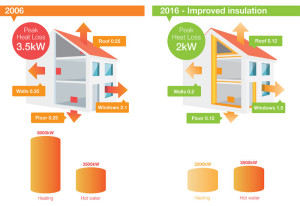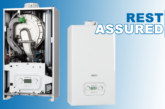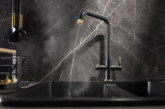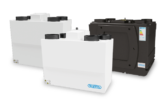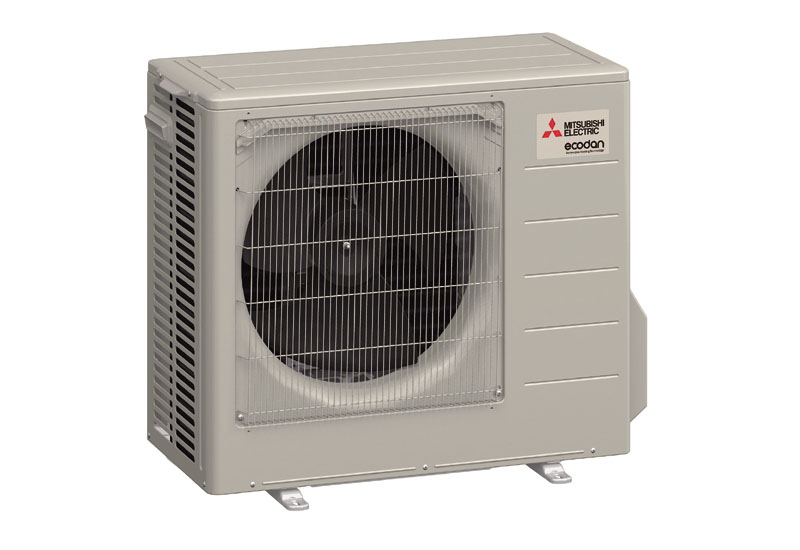
PHPD recently visited Mitsubishi Electric’s Hatfield HQ to find out why the company’s latest heat pump is designed specifically for the new-build residential sector.
The fact that new home construction is growing is good news for the wider construction industry – not just for housebuilders. It should come as little surprise that this trend has not gone unrecognised by product manufactures either with a number of companies in the process of launching product ranges specifically designed to fit the requirements of the new-build sector.
One such company is Mitsubishi Electric. It launched a new version of its Ecodan Heat Pump at the end of January – designed with new-builds in mind. The system is a 4kW Ecodan air source heat pump which will satisfy the heating load of a new home, but also meets the hot water requirements – primarily by using a thermal store.
The impact of insulation
New homes built today differ from previous ones because the requirement for hot water is likely to exceed the demand for heating for the first time. A reduction in fabric U-values and thermal bridging has reduced the energy requirements for heating and also allows for smaller plant.
“What is needed is a new way of delivering energy efficient heating and hot water”, explains Jordan Jeewood, Ecodan technical expert for the company. “We have engineered the Ecodan QUHZ monobloc system to meet this need by providing exceptionally high efficiency in the production of hot water, along with renewable space heating for the home”.
On demand
The Ecodan QUHZ unit is MCS-Approved and delivers water at 70ºC to a packaged 200 litre thermal store. From this thermal store, mains water is heated directly up to 65ºC via the company’s plate heat exchanger, meaning the homeowner receives hot water on demand.
“We have introduced this new way of delivering hot water to the new-build sector because we see a real potential for modern homes to receive reliable hot water and heating in a low carbon, energy efficient way that will help the country reduce overall emissions.”
“This model uses CO2 as a refrigerant to ensure a large delta T between the flow and return temperatures to and from the outdoor unit”, adds Jeewood. “This delivers the high levels of efficiency that enable the system to meet the high hot water, low heating requirements of today’s new-build properties”.
The fundamental design, application and control of the Ecodan QUHZ is exactly the same as the rest of the range with advanced control logic within the thermal store allowing the system to deliver high efficiency.
In addition to high efficiency levels, with a Seasonal Co-efficient of Performance (SCOP) of 3 for hot water and 2.9 for heating, the Ecodan QUHZ poses no risk of legionella because it does not store hot water. At the same time, it is still able to provide a variable hot water capacity, with water heated directly as required.
The system also includes automatic in-built in energy monitoring, using the company’s MELCloud, internet-based system, which allows for full control and monitoring from anywhere in the world.
Keep it quiet
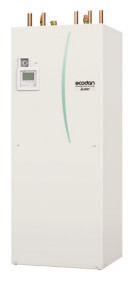
With many new homes being built in close proximity to one another the issue of noise was one the company was particularly keen on tackling. “As more homes are built and more heat pumps are installed, the operating noise will become an increasingly important factor, so we have deliberately designed the Ecodan QUHZ to address this”, notes Jeewood.
The QUHZ model offers noise levels of 41.2 dB(A) at 1.5 metres from neighbouring properties. The company describes it as “whisper-quiet”.
This new addition to the range means that there is an Ecodan model suitable for both new-build and retro-fit homes in almost any situation”, explains Jeewood.
“We have introduced this new way of delivering hot water to the new-build sector because we see a real potential for modern homes to receive reliable hot water and heating in a low carbon, energy efficient way that will help the country reduce overall emissions”, he concludes.
The alternatives?
The Ecodan QUHZ unit will be of most interest to developers building homes off the gas grid. However, the company believes that the additional cost of delivering mains infrastructure to new developments might make the Ecodan QUHZ an attractive proposition for housebuilders within the grid.
Energy reduction
The UK Government is already committed to reducing CO2 emissions by 80 per cent of 1990 levels, by 2050 and achieving a 34 per cent reduction in greenhouse gas emissions by 2020.
Buildings account for 44 per cent of all UK CO2 emissions and space heating and hot water account for almost 75 per cent of total energy consumed in homes.
“The construction of hundreds of thousands of new-build houses is therefore a golden opportunity to change our approach to how we heat, and provide hot water in a home”, concludes Jeewood.

